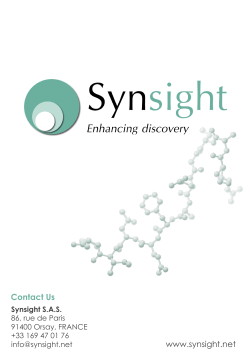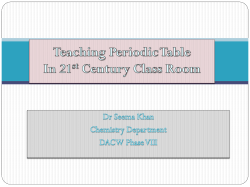
Adresselist 2011-12
Kemisk Forening – Årsmøde 2011 Danish Chemical Society – Annual meeting Danish Chemical Society -‐ Annual Meeting 2011 Thursday, 9th of June 2011, Odense, University of Southern Denmark Time 09.30 – 10.15 Registration 10.15 – 10.20 Welcome 11.30 – 12.45 Plenary Lecture by Prof. A. David Leigh “Making the Tiniest Machines” Lunch and Poster session 12.45 – 14.15 Session lectures I 14.15 – 14.45 Coffee break 14.45 – 16.15 Session lectures II 16.30 – 17.30 Poster Session 17.30 – 18.15 Reception 18.15 – 19.45 Dinner and poster awards 20.00 Departure for participants from Copenhagen and Århus 10.20 – 11.30 Room Outside U45 U45 U45 Fridaybar U42, U43, U46, U47 Fridaybar U42, U43, U46, U47 Fridaybar Campustorv / SDU main entrance SDU restaurant / 1st floor, SDUs main entrance Kemisk Forening – Årsmøde 2011 Danish Chemical Society – Annual meeting Session lectures I 12.45 – 14.15 room Division of Organic Chemistry / Sektion for Organisk Kemi U46 Applications of Synthetic Organic Chemistry in Glycobiology. Prof. Ole Hindsgaul, Carlsberg Laboratory, Copenhagen 12.45 – 13.30 13.30 – 14.15 Unravelling electronic effects in carbohydrates. Prof. Mikael Bols, Department of Chemistry, University of Copenhagen Danish Society for Molecular Spectroscopy / Dansk Forening for Molekylspektroskopi U47 Electronic spectroscopy inside superfluid helium droplets. PhD Dominik Pentlehner, Department of Chemistry, University of Aarhus Attenuated total reflectance and transmission far-‐IR spectroscopic investigation of inorganic compounds in artworks. PhD Elsebeth L. Kendix, Engineering College of Aarhus Relating molecular conformation and reactivity in ultrafast organic photochemistry -‐ Time-‐resolved photoelectron spectroscopy studies. Rasmus Brogaard, Department of Chemistry, University of Copenhagen 12.45 – 13.15 13.15 – 13.45 13.45 – 14.15 Kemisk Forening – Årsmøde 2011 Danish Chemical Society – Annual meeting Danish Society for Environmental Chemistry and Division of Analytical Chemistry / Sektionen for Dansk Selskab for Miljøkemi og Selskabet for Analystisk Kemi U43 Dioxin i fødevarer med højtopløsende GC-‐MS: Analyser og overvågning i Danmark. Søren Sørensen, PhD, Ministeriet for Fødevarer, Landbrug og Fiskeri, Radioaktive isotoper i luft og havvand omkring Danmark. Sven Poul Nielsen, Programleder, Strålingsforskning Risø DTU, Danmarks Tekniske Universitet, Risø Nationallaboratoriet for Bæredygtig Energi Detection and characterization of nanoparticles using AF4-‐MALS/DLS-‐ICP-‐MS. Katrin Loeschner (Post Doc.), Bjørn Schmidt and Erik H. Larsen, Technical University of Denmark, National Food Institute 12.45 – 13.15 Sektionen for Teoretisk Kemi / Division of Theoretical Chemistry 13.15 – 13.45 13.45 – 14.15 U42 Coupled cluster study of Xray absorption spectroscopies. Dr. Sonia Coriani, Department of Chemistry, Aarhus University Simulations of Ion Pumps. Dr. Himanshu Khandelia, Department of Physics and Chemistry, University of Southern Denmark Coherent Multistate Theory for Molecular Wires: Cross-‐over from tunneling to hopping. Dr. Thorsten Hansen, Kemisk Fysik, Lund University 12.45 – 13.15 13.15 – 13.45 13.45 – 14.15 Kemisk Forening – Årsmøde 2011 Danish Chemical Society – Annual meeting Session lectures II 14.45 – 16.15 Division of Organic Chemistry / Sektion for Organisk Kemi U46 Organocatalysis -‐ New Concepts. Prof. Karl Anker Jørgensen, Center for Catalysis, University of Aarhus PhD-‐award winner ”Organic Chemistry” – award lecture. 14.45 – 15.30 PhD-‐award winner ”Organic Chemistry” – award lecture. 15.30 – 15.50 15.50 – 16.15 Sektionen for Uorganisk Kemi / Division of Inorganic Chemistry U47 Natural and Rational Evolution of Metalloproteins: From Quantum Mechanics to Physiological and Industrial Applications. Prof. Kasper Planeta Kepp, Department of Chemistry, Technical University of Denmark High-‐valent Metal Centres with Pi-‐donor ligands Erik Donovan Hedegaard, Department of Physics and Chemistry, University of Southern Denmark X-‐ray magnetic circular dichroism for the study of 3d-‐4f molecular nanomagnets. Dr. Jan Dreiser, Paul Scherrer Institute, Villigen, Switzerland 14.45 – 15.15 Dansk Selskab for Historisk Kemi / The Danish Society of the History of Chemistry U43 Johan Kjeldahl (1849 – 1900) Meget om hans metode og noget om hans liv. Professor, dr. philos. Ragnar Bye, University of Oslo Et liv i aktivering. Neutronaktiveringsanalysen. Dr. K. Heydorn, Technical University of Denmark Flow Injection Analysis. Prof. Elo Harald Hansen, Technical University of Denmark 14.45 – 15.15 15.15 – 15.45 15.45 – 16.15 15.15 – 15.45 15.45 – 16.15 Kemisk Forening – Årsmøde 2011 Danish Chemical Society – Annual meeting Abstract – Plenary Lecture held by Prof. A. David Leigh School of Chemistry, University of Edinburgh, The King’s Buildings, West Mains Road, Edinburgh EH9 3JJ, United Kingdom (David.Leigh@ed.ac.uk; http//www.catenane.net or www.rotaxane.net) Making the Tiniest Machines Over the past few years some of the first examples of synthetic molecular level machines and motors—all be they primitive by biological standards—have been developed. These molecules respond to light, chemical and electrical stimuli, inducing motion of interlocked components held together by hydrogen bonding or other weak molecular interactions. Perhaps the best way to appreciate the technological potential of controlled molecular-‐level motion is to recognise that nanomotors and molecular-‐level machines lie at the heart of every significant biological process. Over billions of years of evolution Nature has not repeatedly chosen this solution for achieving complex task performance without good reason. In stark contrast to biology, none of mankind’s fantastic myriad of present day technologies exploit controlled molecular-‐level motion in any way at all: every catalyst, every material, every polymer, every pharmaceutical, every chemical reagent, all function exclusively through their static or equilibrium dynamic properties. When we learn how to build artificial structures that can control and exploit molecular level motion, and interface their effects directly with other molecular-‐level sub-‐ structures and the outside world, it will potentially impact on every aspect of functional molecule and materials design. An improved understanding of physics and biology will surely follow. • (Review) "Synthetic Molecular Motors and Mechanical Machines" Angew Chem Int Ed, 46, 72-‐191 (2007). • "A Synthetic Small Molecule That Can Walk Down a Track" Nature Chem, 2, 96-‐101 (2010) • "Operation Mechanism of a Molecular Machine Revealed Using Time-‐Resolved Vibrational Spectroscopy" Science, 328, 1255-‐1258 (2010) • "Hybrid Organic-‐Inorganic Rotaxanes and Molecular Shuttles" Nature, 458, 314-‐318 (2009) • "A Molecular Information Ratchet" Nature, 445, 523-‐527 (2007) • "Macroscopic Transport by Synthetic Molecular Machines" Nature Mater, 4, 704-‐710 (2005) • "A Reversible Synthetic Rotary Molecular Motor" Science, 306, 1532-‐1537 (2004) • "Unidirectional Rotation in a Mechanically Interlocked Molecular Rotor" Nature, 424, 174-‐179 (2003)
© Copyright 2025










